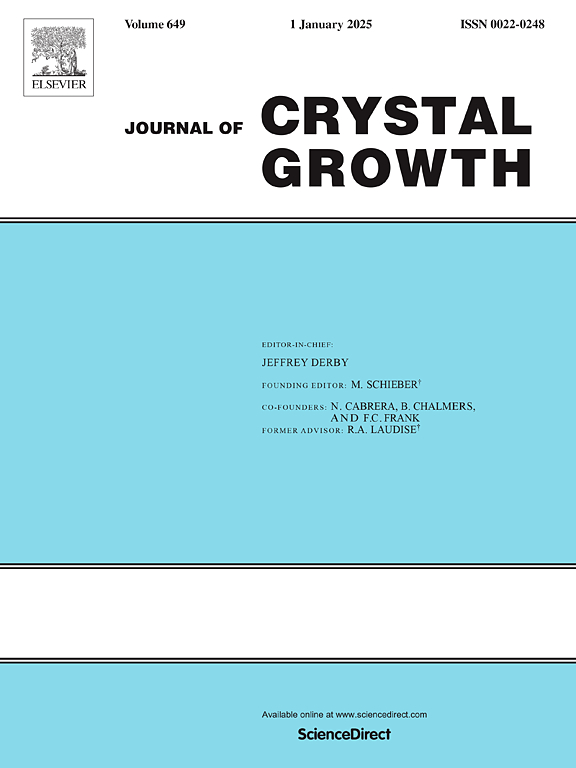Optimization of process parameters to control diameter fluctuation during the monocrystalline silicon growth by hybrid neural network model and genetic algorithm
IF 2
4区 材料科学
Q3 CRYSTALLOGRAPHY
引用次数: 0
Abstract
This study aims to construct a neural network-genetic algorithm collaborative optimization framework through a data-driven approach to break the challenge of diameter fluctuation control under multi-parameter coupling. Based on real-time data from the isothermal stage of industrial single crystal furnaces, the Grey Wolf Optimization algorithm is used to dynamically optimize the weights and hyperparameters of the Multi-Layer Perceptron. Consequently, a high-precision surrogate model of the relationship between process parameters (heater power, crystal pulling speed, crucible lift speed) and diameter fluctuation is established. Meanwhile, the thermal field stability is optimized by the Genetic Algorithm (i.e., a global search of the optimal parameter combination). Verified by factory measurements, the model prediction error is less than 5 %, and the optimal solutions for heater power, crystal pulling and crucible lift speed are 53.64 kW, 1.308 mm/min, and 0.163 mm/min, respectively. Actual production shows that the average diameter fluctuation of the crystal rods in the optimization group decreased from 1.48 ± 0.23 mm (original process) to 0.60 ± 0.15 mm (mean ± standard deviation), a reduction of 59.4 %. The coupled method significantly enhances the intelligence level of the single crystal silicon growth process, and provides a generalizable optimization paradigm for the preparation of other semiconductor crystals.
利用混合神经网络模型和遗传算法优化单晶硅生长过程中控制直径波动的工艺参数
本研究旨在通过数据驱动的方法构建神经网络遗传算法协同优化框架,突破多参数耦合下直径波动控制的挑战。基于工业单晶炉等温阶段的实时数据,采用灰狼优化算法对多层感知器的权值和超参数进行动态优化。由此建立了工艺参数(加热器功率、拔晶速度、坩埚升速)与直径波动关系的高精度代理模型。同时,采用遗传算法(即全局搜索最优参数组合)对热场稳定性进行优化。经工厂实测验证,模型预测误差小于5%,加热器功率、拔晶速度和坩埚提升速度的最优解分别为53.64 kW、1.308 mm/min和0.163 mm/min。实际生产表明,优化组结晶棒的平均直径波动由原工艺的1.48±0.23 mm减小到0.60±0.15 mm(平均值±标准差),降幅达59.4%。该耦合方法显著提高了单晶硅生长过程的智能化水平,并为其他半导体晶体的制备提供了可推广的优化范例。
本文章由计算机程序翻译,如有差异,请以英文原文为准。
求助全文
约1分钟内获得全文
求助全文
来源期刊

Journal of Crystal Growth
化学-晶体学
CiteScore
3.60
自引率
11.10%
发文量
373
审稿时长
65 days
期刊介绍:
The journal offers a common reference and publication source for workers engaged in research on the experimental and theoretical aspects of crystal growth and its applications, e.g. in devices. Experimental and theoretical contributions are published in the following fields: theory of nucleation and growth, molecular kinetics and transport phenomena, crystallization in viscous media such as polymers and glasses; crystal growth of metals, minerals, semiconductors, superconductors, magnetics, inorganic, organic and biological substances in bulk or as thin films; molecular beam epitaxy, chemical vapor deposition, growth of III-V and II-VI and other semiconductors; characterization of single crystals by physical and chemical methods; apparatus, instrumentation and techniques for crystal growth, and purification methods; multilayer heterostructures and their characterisation with an emphasis on crystal growth and epitaxial aspects of electronic materials. A special feature of the journal is the periodic inclusion of proceedings of symposia and conferences on relevant aspects of crystal growth.
 求助内容:
求助内容: 应助结果提醒方式:
应助结果提醒方式:


